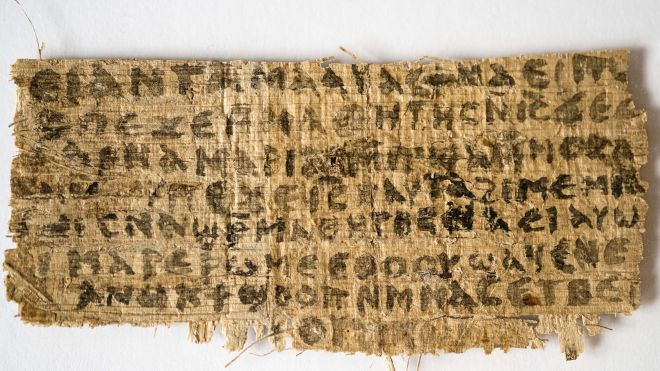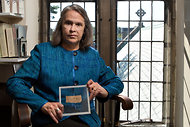Gesù era sposato. In un papiro scritto in copto parla di sua moglie. A identificare la frase una studiosa di Harvard. Ripubblico qui di seguito l’articolo del  Guardian di qualche mese fa:
Guardian di qualche mese fa:
Photograph by Karen L. King
A Faded Piece of Papyrus Refers to Jesus’ Wife
By LAURIE GOODSTEIN
Published: September 18, 2012 1522 Comments
CAMBRIDGE, Mass. — A historian of early Christianity at Harvard Divinity School has identified a scrap of papyrus that she says was written in Coptic in the fourth century and contains a phrase never seen in any piece of Scripture: “Jesus said to them, ‘My wife …’ ” The faded papyrus fragment is smaller than a business card, with eight lines on one side, in black ink legible under a magnifying glass. Just below the line about Jesus having a wife, the papyrus includes a second provocative clause that purportedly says, “she will be able to be my disciple.”
The finding was made public in Rome on Tuesday at theInternational Congress of Coptic Studies by Karen L. King, a historian who has published several books about new Gospel discoveries and is the first woman to hold the nation’s oldest endowed chair, the Hollis professor of divinity.
The provenance of the papyrus fragment is a mystery, and its owner has asked to remain anonymous. Until Tuesday, Dr. King had shown the fragment to only a small circle of experts in papyrology and Coptic linguistics, who concluded that it is most likely not a forgery. But she and her collaborators say they are eager for more scholars to weigh in and perhaps upend their conclusions.
Even with many questions unsettled, the discovery could reignite the debate over whether Jesus was married, whether Mary Magdalene was his wife and whether he had a female disciple. These debates date to the early centuries of Christianity, scholars say. But they are relevant today, when global Christianity is roiling over the place of women in ministry and the boundaries of marriage.
The discussion is particularly animated in the Roman Catholic Church, where despite calls for change, the Vatican has reiterated the teaching that the priesthood cannot be opened to women and married men because of the model set by Jesus.
Dr. King gave an interview and showed the papyrus fragment, encased in glass, to reporters from The New York Times, The Boston Globe and Harvard Magazine in her garret office in the tower at Harvard Divinity School last Thursday.
She repeatedly cautioned that this fragment should not be taken as proof that Jesus, the historical person, was actually married. The text was probably written centuries after Jesus lived, and all other early, historically reliable Christian literature is silent on the question, she said.
But the discovery is exciting, Dr. King said, because it is the first known statement from antiquity that refers to Jesus speaking of a wife. It provides further evidence that there was an active discussion among early Christians about whether Jesus was celibate or married, and which path his followers should choose.
“This fragment suggests that some early Christians had a tradition that Jesus was married,” she said. “There was, we already know, a controversy in the second century over whether Jesus was married, caught up with a debate about whether Christians should marry and have sex.”
Dr. King first learned about what she calls “The Gospel of Jesus’s Wife” when she received an e-mail in 2010 from a private collector who asked her to translate it. Dr. King, 58, specializes in Coptic literature, and has written books on the Gospel of Judas, the Gospel of Mary of Magdala, Gnosticism and women in antiquity.
The owner, who has a collection of Greek, Coptic and Arabic papyri, is not willing to be identified by name, nationality or location, because, Dr. King said, “He doesn’t want to be hounded by people who want to buy this.”
When, where or how the fragment was discovered is unknown. The collector acquired it in a batch of papyri in 1997 from the previous owner, a German. It came with a handwritten note in German that names a professor of Egyptology in Berlin, now deceased, and cited him calling the fragment “the sole example” of a text in which Jesus claims a wife.
The owner took the fragment to the Divinity School in December 2011 and left it with Dr. King. In March, she carried the fragment in her red handbag to New York to show it to two papyrologists: Roger Bagnall, director of the Institute for the Study of the Ancient World, at New York University, and AnneMarie Luijendijk, an associate professor of religion at Princeton University.
They examined the scrap under sharp magnification. It was very small — only 4 by 8 centimeters. The lettering was splotchy and uneven, the hand of an amateur, but not unusual for the time period, when many Christians were poor and persecuted.
It was written in Coptic, an Egyptian language that uses Greek characters — and more precisely, in Sahidic Coptic, a dialect from southern Egypt, Dr. Luijendijk said in an interview.
What convinced them it was probably genuine was the fading of the ink on the papyrus fibers, and traces of ink adhered to the bent fibers at the torn edges. The back side is so faint that only five words are visible, one only partly: “my moth[er],” “three,” “forth which.”
“It would be impossible to forge,” said Dr. Luijendijk, who contributed to Dr. King’s paper.
Dr. Bagnall reasoned that a forger would have had to be expert in Coptic grammar, handwriting and ideas. Most forgeries he has seen were nothing more than gibberish. And if it were a forgery intended to cause a sensation or make someone rich, why would it have lain in obscurity for so many years?
“It’s hard to construct a scenario that is at all plausible in which somebody fakes something like this. The world is not really crawling with crooked papyrologists,” Dr. Bagnall said.
The piece is torn into a rough rectangle, so that the document is missing its adjoining text on the left, right, top and bottom — most likely the work of a dealer who divided up a larger piece to maximize his profit, Dr. Bagnall said.
Much of the context, therefore, is missing. But Dr. King was struck by phrases in the fragment like “My mother gave to me life,” and “Mary is worthy of it,” which resemble snippets from the Gospels of Thomas and Mary. Experts believe those were written in the late second century and translated into Coptic. She surmises that this fragment is also copied from a second-century Greek text.
The meaning of the words, “my wife,” is beyond question, Dr. King said. “These words can mean nothing else.” The text beyond “my wife” is cut off.
Dr. King did not have the ink dated using carbon testing. She said it would require scraping off too much, destroying the relic. She still plans to have the ink tested by spectroscopy, which could roughly determine its age by its chemical composition.
Dr. King submitted her paper to The Harvard Theological Review, which asked three scholars to review it. Two questioned its authenticity, but they had seen only low-resolution photographs of the fragment and were unaware that expert papyrologists had seen the actual item and judged it to be genuine, Dr. King said. One of the two questioned the grammar, translation and interpretation.
Ariel Shisha-Halevy, an eminent Coptic linguist at Hebrew University in Jerusalem, was consulted, and said in an e-mail in September, “I believe — on the basis of language and grammar — the text is authentic.”
Major doubts allayed, The Review plans to publish Dr. King’s article in its January issue.
Dr. King said she would push the owner to come forward, in part to avoid stoking conspiracy theories.
The notion that Jesus had a wife was the central conceit of the best seller and movie “The Da Vinci Code.” But Dr. King said she wants nothing to do with the code or its author: “At least, don’t say this proves Dan Brown was right.”
A version of this article appeared in print on September 19, 2012, on page A1 of the New York edition with the headline: A Faded Piece of Papyrus Refers to Jesus’ Wife.
Professor Karen L. King, in her office at Harvard Divinity School, held a fragment of papyrus that she says was written in Coptic in the fourth century and contains a reference to Jesus’ wife.


